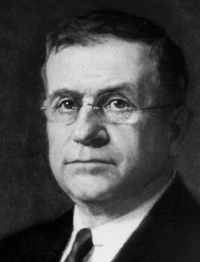Harold L. Ickes
|
|
Harold LeClair Ickes (March 15, 1874–February 3, 1952) was a U.S. administrator and political figure. He served as Secretary of the Interior for thirteen years, from 1933 to 1946, and was known as President Franklin D. Roosevelt's point man for the New Deal.

| Contents |
Early years
Ickes was born on a farm outside of Hollidaysburg, Pennsylvania. He moved to Chicago at the age of 16 and attended Englewood High School there. After graduating, he worked his way through the University of Chicago, finishing with an B.A. in 1897.
He first worked as a newspaper reporter for The Chicago Record and later for The Chicago Tribune. He obtained a law degree from the University of Chicago in 1907, but rarely practiced. Instead, he became active in reform politics.
Politics
Initially a Republican in Chicago, Ickes was never part of the establishment. He was unsatisfied with Republican policies and joined Theodore Roosevelt's Bull Moose movement in 1912. After returning to the Republican fold, he campaigned for progressive Republicans Charles Evans Hughes (1916) and Hiram Johnson (1920 and 1924).
He fought lengthy and legendary battles first with Chicago figures Samuel Insull, the utilities magnate, William Hale Thompson, the mayor, and Robert R. McCormick, the owner of The Chicago Tribune. Later he had an ongoing battle with Thomas Dewey, the presidential candidate.
Although locally active in Chicago politics, he was unknown nationally until 1933. After Franklin D. Roosevelt was elected president in 1932, he began putting together his cabinet. His advisers thought the Democrat president needed a progressive Republican to attract middle of the road voters. He sought out Hiram Johnson, a Republican Senator at the time who had supported Roosevelt in the campaign, but Johnson was uninterested. Johnson did, however, recommend an old ally, Ickes.
Ickes was a strong supporter of both civil rights and civil liberties. He had been the president of the Chicago NAACP, and supported African American contralto Marian Anderson when the Daughters of the American Revolution pohibited her from performing in their Constitution Hall. He also was a outspoken critic of the internment of Japanese Americans during World War II.
Secretary of the Interior
Ickes served simultaneously in several major roles for President Roosevelt. Although he was the Secretary of the Interior, he was better known to the public for other roles in which he served simultaneously. He was the director of the Public Works Administration. Here he directed billions of dollars of projects designed to lure private investment and provide employment at the depth of the Great Depression. He fought incessantly to keep the projects out of politics, instead directing them to places producing the best results. His precise management of the PWA budget and his opposition to corruption earned him the name "Honest Harold".
After the Hindenburg exploded, Nazi Germany sought to obtain helium to replace the flammable hydrogen in their fleet of dirigibles. Ickes opposed the sale, although practically every other member of the Cabinet supported it, along with the President himself. Ickes would not back down, fearing military use of the dirigible. Germany could not obtain the helium from other sources. Hence, Ickes virtually shut down the German dirigible program himself.
The ARAMCO oil corporation, through Secretary of the Interior Ickes, got Roosevelt to agree to Lend Lease aid to Saudi Arabia, which would involve the U.S. government there and create a shield for the interests of ARAMCO.
Although he stayed on in President Harry S. Truman's cabinet after Roosevelt died in April 1945, he resigned from office within a year. In February 1946, Truman nominated Edwin C. Pauley to be Secretary of the Navy. Pauley was the former Democratic Party national treasurer. He once suggested to Ickes that $300,000 in campaign funds could be raised if Ickes would drop his fight for title to oil-rich offshore lands. Ickes wrote a 2,000-word resignation letter, reading in part: "I don't care to stay in an Administration where I am expected to commit perjury for the sake of the party. . . I do not have a reputation for dealing recklessly with the truth."
Critiques and Battles
Ickes was known for his acerbic wit and took joy in verbal battles. He often took verbal abuse too. For instance, Roosevelt selected Ickes to deliver a response following the nomination of Wendell Willkie. In response to Ickes' comments, Senator H. Styles Bridges called Ickes "a common scold puffed up by high office" and a "Hitler in short pants".
In September 1944, Thomas Dewey, the Republican nominee for president, promised to fire Ickes if elected. Ickes penned a letter of resignation to Dewey and it was widely printed in the press. Ickes wrote, in part:
- Hence, I hereby resign as Secretary of the Interior effective, if, as and when the incredible comes to pass and you become the President of the United States. However, as a candidate for that office you should have known the primary school fact that the Cabinet of an outgoing President automatically retires with its chief.
Family
He married Anna Wilmarth Thompson in 1911. She died in an automobile accident on August 31, 1935. He married Jane Dahlman, who was 25 at the time, on May 24, 1938. He had one son, Raymond, by his first wife and two children by his second wife: Harold McEwen (who was a deputy chief of staff for President Clinton) and Elizabeth Jane. He also had a foster son, Robert Harold Ickes, born in 1913.
Writings
Ickes published five books: New Democracy (1934), The Autobiography of a Curmudgeon (1943), and his three-volume Secret Diary (1953-54).
Sources
- Harold L. Ickes Dead at 77; Colorful Figure in New Deal, New York Times, February 4, 1952.
- Eleanor Roosevelt National Historic Site (http://www.nps.gov/elro/glossary/ickes-harold.htm)
| Preceded by: Ray Lyman Wilbur | U.S. Secretary of the Interior 1933–1946 | Succeeded by: Julius Krug |
